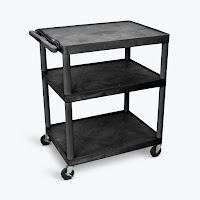Buying Guide: Surveying Tripods
All professionals work with specific tools to get the job done. Land surveyors, in particular, use a variety of surveying instruments for different tasks.
But as with most tools, surveying equipment cannot perform optimally without the right accessories. And when it comes to optical instruments and levels, a tripod for surveying can help professionals make the most of their equipment.
Without a surveying tripod, land surveyors would not have a stable platform to keep their instruments level and plumb or a way to increase these instruments’ working range. That said, there’s no doubt that it’s an indispensable part of any surveyor’s toolbox.
If you’re planning to get a surveying tripod, you can check out this top 10 list of the best surveying tripods on the market. Or read on and learn what factors you need to consider before buying the best one for the job.
Surveying tripods come in different materials, but the most common ones are wood, aluminum, carbon fiber, and fiberglass.
While wood surveying tripods are extremely durable and stable, they are relatively difficult to carry because of their cumbersome weight. They are, however, still a perfect choice for construction sites. When you do opt to get a wood surveying tripod, make sure that it’s coated with a paint finish or protective plastic material, which enables it to be water- and wear-resistant.
Apart from being ultra-portable, aluminum surveying tripods are rust- and wear-resistant, so they can easily endure tough field conditions.
But if you need to go beyond the height that most surveying tripods offer, you can find a tripod that comes with an elevating column. Elevating tripods have both telescoping legs and elevating columns to give surveying instruments an extra height boost.
Some of the common tripod clamps are a screw clamp, which you can tighten using its screws, a quick-release clamp with a lever for quick setups, and a combination clamp, which offers the functionalities of both screw and quick-release clamps.
But as with most tools, surveying equipment cannot perform optimally without the right accessories. And when it comes to optical instruments and levels, a tripod for surveying can help professionals make the most of their equipment.
Without a surveying tripod, land surveyors would not have a stable platform to keep their instruments level and plumb or a way to increase these instruments’ working range. That said, there’s no doubt that it’s an indispensable part of any surveyor’s toolbox.
If you’re planning to get a surveying tripod, you can check out this top 10 list of the best surveying tripods on the market. Or read on and learn what factors you need to consider before buying the best one for the job.
Material
Working in the field entails working with harsh job site conditions. As a result, most surveying tripods are made of durable materials that can withstand the toughest outdoor elements.Surveying tripods come in different materials, but the most common ones are wood, aluminum, carbon fiber, and fiberglass.
Wood
Traditional surveying tripods are typically made of wood. As a temperature-resistant material, wood will remain stable in any weather and won’t shrink or expand in extreme temperature conditions.While wood surveying tripods are extremely durable and stable, they are relatively difficult to carry because of their cumbersome weight. They are, however, still a perfect choice for construction sites. When you do opt to get a wood surveying tripod, make sure that it’s coated with a paint finish or protective plastic material, which enables it to be water- and wear-resistant.
Aluminum
Another popular choice of surveying tripods is an aluminum tripod. While it isn’t as temperature-resistant as wood, aluminum is incredibly affordable and lightweight—making it the best option for quick assemblies.Apart from being ultra-portable, aluminum surveying tripods are rust- and wear-resistant, so they can easily endure tough field conditions.
Carbon Fiber
While carbon fiber is likely to shatter in extremely cold weather, it’s still a common choice of surveying tripods. Like aluminum, carbon fiber surveying tripods are lightweight yet sturdy, so they’re easy to carry and can last for years of use.Fiberglass
Temperature-resistant and lightweight, fiberglass surveying tripods are some of the best kinds of tripods out there. They can remain in pristine condition—even when exposed to extreme temperature changes for long periods—and are extremely portable as well.Height
Virtually every surveying tripod on the market comes with extendable legs. Because surveying tripods are used for increasing an instrument’s working range, they come in different extended heights and feature locking clamps.But if you need to go beyond the height that most surveying tripods offer, you can find a tripod that comes with an elevating column. Elevating tripods have both telescoping legs and elevating columns to give surveying instruments an extra height boost.
Clamps
Even if you get one of the tallest surveying tripods on the market, its height won’t matter if it doesn’t have a secure clamp.Some of the common tripod clamps are a screw clamp, which you can tighten using its screws, a quick-release clamp with a lever for quick setups, and a combination clamp, which offers the functionalities of both screw and quick-release clamps.

Comments
Post a Comment